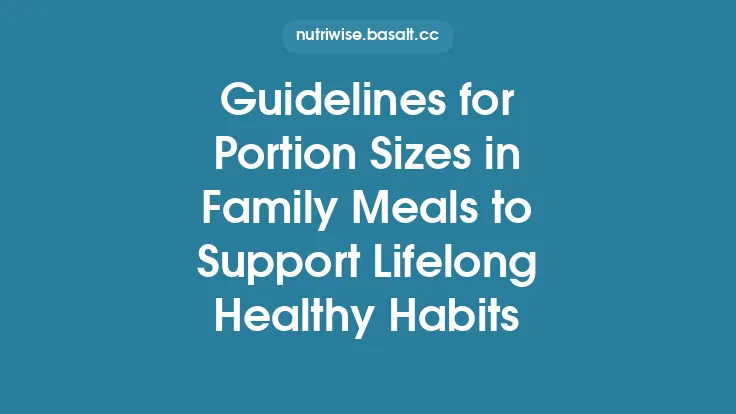Portion control is often the missing link between knowing what to eat and actually reaping the cardiovascular benefits of a heart‑healthy diet. While countless recipes and cooking techniques can lower cholesterol, reduce sodium, or boost omega‑3 intake, the ultimate impact of those foods hinges on how much of them we place on our plates. Even the most nutrient‑dense meals can become counterproductive when consumed in excess, leading to weight gain, elevated blood pressure, and increased strain on the heart. Understanding the science behind portion sizes, learning practical ways to gauge them, and tailoring portions to individual needs are essential steps toward sustainable cardiovascular wellness.
The Physiology of Portion Size and Heart Health
Energy balance and cardiac workload
The heart’s primary job is to pump blood throughout the body, delivering oxygen and nutrients while removing waste products. When caloric intake consistently exceeds energy expenditure, excess energy is stored as adipose tissue. Visceral fat—fat stored around internal organs—produces inflammatory cytokines and hormones that can raise blood pressure, impair insulin sensitivity, and promote atherosclerosis. By aligning portion sizes with actual energy needs, you help maintain a healthy body weight and reduce the mechanical and metabolic load on the cardiovascular system.
Macronutrient distribution and vascular function
Portion size influences the absolute amount of macronutrients (carbohydrates, proteins, fats) consumed in a meal. High‑glycemic carbohydrates in large portions can cause rapid spikes in blood glucose and insulin, which over time may contribute to endothelial dysfunction. Conversely, moderate portions of lean protein and unsaturated fats support endothelial health by providing essential amino acids and fatty acids that aid nitric oxide production, a key vasodilator. Balancing portions ensures that each macronutrient contributes positively rather than overwhelming the system.
Micronutrient density versus volume
Micronutrients such as potassium, magnesium, and antioxidants play direct roles in blood pressure regulation and oxidative stress reduction. Because these nutrients are often concentrated in vegetables, fruits, legumes, and nuts, a portion‑controlled approach that emphasizes volume (e.g., a larger plate of non‑starchy vegetables) can increase micronutrient intake without adding excessive calories. This “nutrient‑dense, low‑energy” strategy is a cornerstone of heart‑healthy eating.
Determining Your Personal Portion Targets
Basal metabolic rate (BMR) and activity level
Your BMR—calories burned at rest—forms the baseline for daily energy needs. Multiplying BMR by an activity factor (sedentary, lightly active, moderately active, very active) yields total daily energy expenditure (TDEE). Portion sizes should be calibrated so that the sum of calories from all meals and snacks approximates your TDEE, allowing for a modest caloric deficit (if weight loss is desired) or maintenance.
Age, sex, and cardiovascular risk profile
Men generally have higher caloric needs than women due to greater lean body mass, while older adults often require fewer calories because of reduced basal metabolism and activity. Individuals with hypertension, dyslipidemia, or diabetes may benefit from tighter control of sodium, saturated fat, and refined carbohydrate portions, respectively. Consulting a registered dietitian can help translate these variables into concrete portion recommendations.
Portion‑size equations for the major food groups
| Food Group | Standard Portion (≈ 100 kcal) | Recommended Daily Servings* |
|---|---|---|
| Non‑starchy vegetables | 1 cup raw or ½ cup cooked | 3–5 servings |
| Whole fruits | 1 medium fruit or ½ cup sliced | 2–3 servings |
| Whole grains (cooked) | ½ cup | 3–4 servings |
| Legumes (cooked) | ½ cup | 1–2 servings |
| Lean protein (cooked) | 3 oz (≈ 85 g) | 2–3 servings |
| Nuts & seeds | ¼ cup | ≤ 1 serving |
| Healthy oils (olive, canola) | 1 tsp | ≤ 2 servings |
| Dairy (low‑fat) | 1 cup milk or ½ cup yogurt | 2–3 servings |
\*Servings are a general guideline; individual needs may vary.
Visual Cues and the “Plate Method”
The ½‑½‑¼ rule
- ½ of the plate: Non‑starchy vegetables (leafy greens, cruciferous veggies, peppers). These are low in calories but high in fiber, potassium, and antioxidants.
- ¼ of the plate: Lean protein (skinless poultry, fish, tofu, legumes). This portion supplies essential amino acids without excessive saturated fat.
- ¼ of the plate: Whole grains or starchy vegetables (brown rice, quinoa, sweet potatoes). Keeping this portion modest helps control carbohydrate load and total caloric intake.
Color and texture as guides
A colorful plate—multiple hues of vegetables—naturally increases volume while keeping calories low. Adding varied textures (crunchy raw veggies, creamy legumes) can enhance satiety, reducing the tendency to overeat.
Practical Tools for Portion Control
Measuring devices
- Digital kitchen scales: Provide the most accurate measurement, especially for protein portions and nuts where volume can be misleading.
- Measuring cups and spoons: Useful for grains, legumes, and oils. Remember that a “cup” of cooked rice is roughly 150 g, not 250 g.
Portion‑size containers
Pre‑portioning meals into reusable containers (e.g., ½‑cup, 1‑cup, 2‑cup compartments) simplifies daily decision‑making and reduces reliance on visual estimation.
Smartphone apps
Many nutrition apps allow you to log foods by weight or volume, automatically calculating calories, macronutrients, and micronutrients. Some also feature barcode scanners for packaged items, making it easier to track hidden sources of sodium or added sugars.
Mindful Eating Strategies
Slow down and savor
Eating at a slower pace gives the brain time (≈ 20 minutes) to register satiety signals from hormones such as leptin and peptide YY. This can naturally curb portion overconsumption.
Pre‑meal hydration
Drinking a glass of water 15–20 minutes before a meal can reduce hunger intensity, leading to smaller portions without compromising nutrient intake.
Set a “stop” cue
Designate a visual cue—such as placing a fork down after each bite or pausing when the plate is half empty—to prompt a check‑in with your fullness level.
Adjusting Portions for Special Situations
Exercise days
On days with vigorous activity (≥ 60 minutes of moderate‑to‑vigorous exercise), modestly increase carbohydrate and protein portions to replenish glycogen stores and support muscle repair, while still respecting overall caloric balance.
Travel and dining out
Restaurant portions are often 1.5–2× larger than standard servings. Strategies include:
- Requesting half‑portion or “to‑go” boxes for half the meal before it arrives.
- Sharing an entrée with a companion.
- Prioritizing protein and vegetables, and limiting high‑calorie sauces or dressings.
Medical conditions
- Hypertension: Even though sodium reduction is covered elsewhere, controlling portion size of processed meats and cheese (common sodium sources) indirectly reduces sodium load.
- Diabetes: Carbohydrate counting is essential; using portion‑size tools helps keep carbohydrate intake within target ranges, stabilizing blood glucose and reducing cardiovascular risk.
The Role of Fiber in Portion Management
Dietary fiber adds bulk without adding digestible calories, promoting satiety and improving lipid profiles. Aim for at least 25 g of fiber per day for women and 38 g for men, primarily from whole fruits, vegetables, legumes, and whole grains. Incorporating a high‑fiber side dish (e.g., a bean salad) can increase meal volume, allowing you to eat a larger‑looking plate while keeping total calories in check.
Monitoring Progress and Making Adjustments
Regular self‑assessment
- Weight and waist circumference: Track weekly; a reduction of 1–2 cm in waist circumference often reflects loss of visceral fat.
- Blood pressure and lipid panels: Check at least annually; improvements often correlate with sustained portion control.
Iterative tweaking
If weight loss stalls, consider reducing the grain/starch portion by ¼ cup or swapping a high‑calorie dressing for a vinegar‑based alternative. Conversely, if energy levels dip, modestly increase protein or healthy‑fat portions.
Summary
Balancing portion sizes is a dynamic, evidence‑based practice that directly influences cardiovascular health. By understanding the physiological impact of excess calories, applying personalized portion targets, leveraging visual cues like the plate method, and employing practical tools—from kitchen scales to mindful‑eating techniques—you can transform a heart‑healthy menu into a heart‑healthy lifestyle. Consistent attention to portion control not only supports optimal weight and blood‑pressure management but also maximizes the intake of protective nutrients while minimizing the risk factors that lead to heart disease. Embrace portion awareness as a daily habit, and let each measured bite be a step toward a stronger, healthier heart.





